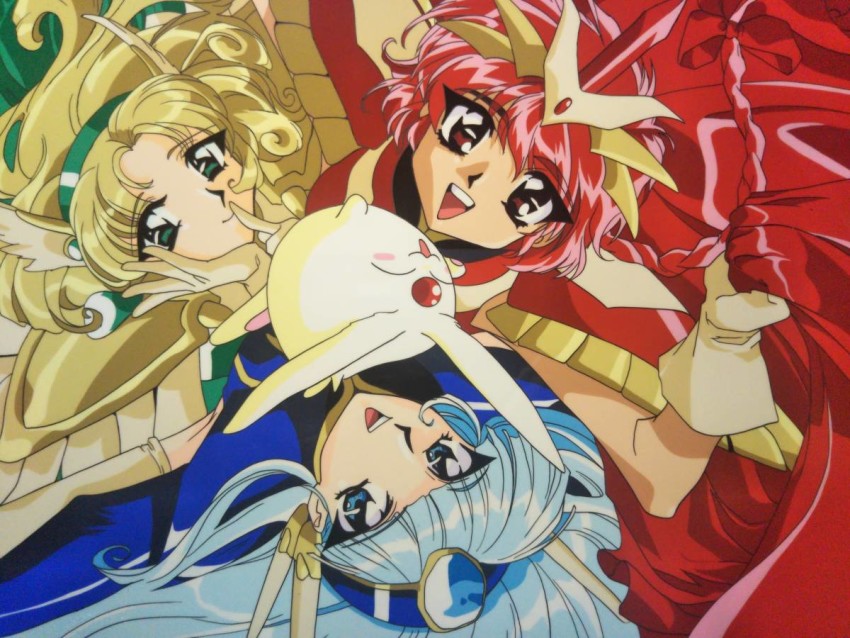Magic Knight Rayearth
June 9, 2020 · 0 comments
By Shelley Pallis.
 Three teenage girls, from different schools, are on an outing to the Tokyo Tower when they are whisked away to the fantasy land of Cephiro. They are destined to become the Magic Knights, a trio of warriors promised in prophecy, who must save Princess Emeraude from her imprisonment at the hands of her former high priest, Zagato. But there’s a catch…
Three teenage girls, from different schools, are on an outing to the Tokyo Tower when they are whisked away to the fantasy land of Cephiro. They are destined to become the Magic Knights, a trio of warriors promised in prophecy, who must save Princess Emeraude from her imprisonment at the hands of her former high priest, Zagato. But there’s a catch…
“You can tell it’s not a simple world,” said writer Nanase Ohkawa in an interview in Animerica, “the kind where there’s a princess, a villain who kidnaps her, and the main character who saves the day and lives happily ever after. Even if the main characters thought that’s the world they got into…”
It’s easy to forget that Rayearth was literally a prime-time anime, broadcast at half past seven in the evenings on Mondays, bearing a tell-tale logo that marked it out as a cultural work that had received funding from the Japanese Arts Council – as if any of the players involved needed a leg-up from the government. The early evening broadcast gives it a conspicuously different tone from many of the shows made in the decades that followed – we are used, now, to late-night broadcasts riddled with fan-service and risqué business, whereas Rayearth belongs to a more innocent age.
Magic Knight Rayearth first appeared in manga form in 1993, the product of a decision at Nakayoshi magazine to hire the all-female collective CLAMP to come up with something that might rival the monster success of the same publication’s earlier Sailor Moon. Ohkawa commented that the collective’s followers had the irritating habit of growing up, so it was always smart to pitch something every now and then for younger readers, in order to capture a new generation of potential CLAMP fans.
This, it seems, was the reasoning behind one of the serial’s odder creative decisions, to name a number of supporting characters, spells and artefacts after prominent Japanese car brands. Ohkawa explained that this was a deliberate decision to help younger Japanese viewers get their heads around all those fantasy names that were inevitably written in katakana. It’s not unlike imagining that all the families in Game of Thrones were named after department stores or DIY franchises.
“Children have a hard time learning names in katakana,” said Ohkawa. “But their fathers tend to be driving cars. If characters bear the same names as the cars in people’s houses, I thought that would be mnemonic enough.” The world of Rayearth itself, however, is not a car name but a calque of the Japanese hikaru no daiichi, the Shining Continent, or “ray-earth.”
Magic Knight Rayearth featured many of the tropes common in magical-girl fiction, starting with the overwhelming positivity of the leading lady Hikaru – unfailingly selfless and ready to help her friends, even when the snooty Umi is complaining and demanding attention, or the specky Fuu is hesitant and dithering. But it also dumps in a skipful of ideas more common in shows aimed at boys, not the least the idea that the girls will fight to save their fantasy world by piloting massive machines (called, er… mashins).
Cephiro, meanwhile, is a fantasy world with a particular kind of magic to it, in which the human will can be made real. In other words, if wishing made it so, dreams can come true in Cephiro, and awesome flights of fantasy and joy enter the realm of possibility. Unfortunately, that carries with it a flipside, since humans overwhelmed with depression or despair can also see their nightmares come true, infesting the land with monsters and bad magic – this becomes a particular issue in the latter half of the Rayearth story, in which the cast have suffered a loss that seems to wound the whole land.
Prefiguring the mixed genres of the later Escaflowne, CLAMP pitched a fantasy quest involving teenage girls piloting giant robots with heavy-handed elemental connections like something out of a sentai team-show. You can even see that in the girls’ names and signature colours – Fire, Air and Sea. But CLAMP also threw in a genre-bending, earth-shattering twist at the end of the first story arc. No spoilers here… but CLAMP’s big revelation created a shock ending, just as the anime adaptation of their series was commissioned for another season. Notably, Ohkawa herself was brought on as a writer on the anime, starting with episode 14, injecting even the serial’s subsequent deviations from the original manga story with a degree of authenticity.
Magic Knight Rayearth is released on UK Blu-ray by Anime Limited.
Leave a Reply